Last brush with fall?
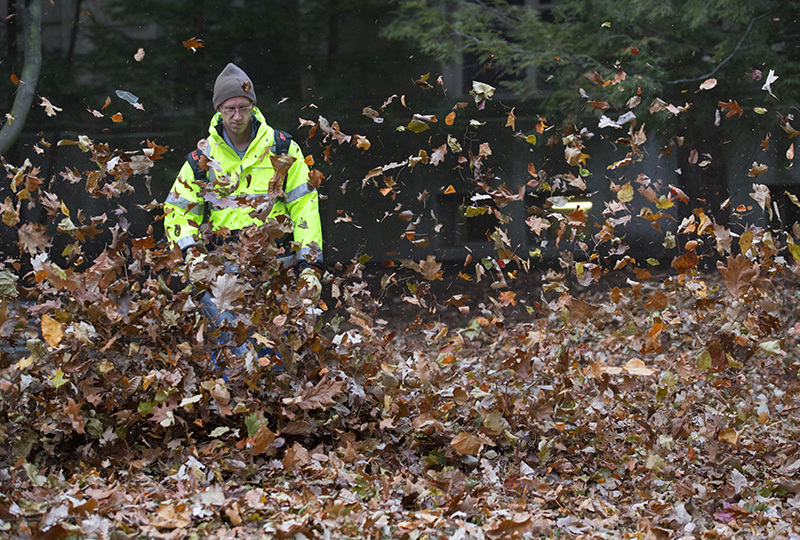
Photo by Christopher Gannon.
Campus services employee Branden Geil moves a mountain of leaves with a leaf blower along the east side of Beardshear Hall recently. He said it was the second time in a week the area needed to be cleared.
"It’s never-ending," Geil said. "We were actually here blowing leaves last week and now we’re back again."
Before long, Geil may replace the leaf blower with a snow thrower.
President Wintersteen on her approach, plans and favorite vacation spot
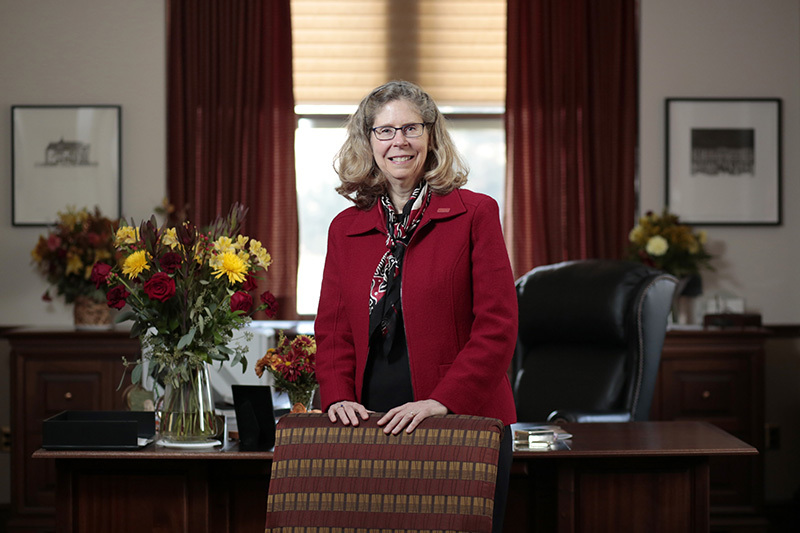
President Wendy Wintersteen in her office in Beardshear Hall on Nov. 27, her second week on the job as Iowa State's new top leader. Photo by Christopher Gannon.
On her second Monday on the job, Nov. 27, President Wendy Wintersteen, former College of Agriculture and Life Sciences dean, sat down with Inside to talk about what she plans to do, how she plans to do it and a few other topics. Here are highlights of that conversation:
You've been in the office for a week. What's been the biggest surprise?
I don't know if I've really had any big surprises yet. I spent a month with Ben Allen in his role as interim president, and we worked closely together almost every day to ensure a smooth transition, so that made a difference. I will say I've been delighted by the events I've been able to attend that represent the broader campus. Walking through the crowds at homecoming, there were so many young women and women my age, who gave me a hug, individuals I didn't know, who told me how pleased they were that a woman had been named president of Iowa State University. I was surprised by that -- just the outpouring of support for me as being the first woman in this role.
Wintersteen begins
Other coverage of new President Wendy Wintersteen in this week's edition of Inside Iowa State:
What are Iowa State's most urgent issues? What needs to be addressed first?
We are having numerous conversations about the budget. Of course, there simply are a lot of unknowns at this point. The Board of Regents is working through its process to determine the tuition increase. We know that the Board of Regents' proposal to the Legislature is about new dollars to support student financial aid at Iowa State University and the other regent universities. I think that shows the commitment to assist students and their families with any tuition increase. We also know that Iowa State had a very tight budget last year. For the most part, our faculty and staff did not receive salary increases. I’m making that a priority to address in this coming year. We work in a competitive market, and we have excellent faculty and staff.
There are a lot of top university leadership roles open, including a couple at the senior vice president level. What's the approach there? Is there a priority?
We have a number of searches underway right now, including the dean of the College of Veterinary Medicine and the vice president for extension and outreach. Very soon the search for the dean of the College of Agriculture and Life Sciences will be announced. We've named an interim senior vice president for university services. Pam Cain is going to serve that role. Also, on Dec. 15, as (chief financial officer and chief of staff) Miles Lackey moves to his new position at Auburn, Pam Cain will be taking on that interim chief financial officer position as well. Kristi Darr has provided excellent leadership as interim vice President for Human Resources. This is another position that we will need to move forward through the search process. It is so important that we find the right people for these key positions. I am grateful that we have very capable leaders who have been willing to step up and fill these roles on an interim basis.
The chief of staff position was new under President Steven Leath. Is that something you'll retain?
I'm definitely going to pursue a chief of staff position, but at this point in time I don't have anyone identified. I'm having conversations with the leadership about their recommendations and ideas. I think that'll take a little time. I might even have an interim serve in that role, as well.
Is it a given that it would be an internal appointment?
I think it probably will be, but it's not a given.
You've mentioned that you'd like to hold some listening sessions on campus. Are there any details you'd like to share about the timing or manner of those?
I'm going to be visiting with the senior leadership team, asking them for their advice on how to conduct those listening sessions. We'll begin to initiate those conversations over the next month and have them broadly announced. I'll be meeting with the formal groups that exist. Obviously, the Faculty Senate, Professional and Scientific Council, Graduate and Professional Student Senate, Student Government. But we really want to hear from everyone who has a constructive thought and helpful idea. How do we go forward? How do we seize the opportunities that are in front of us, address challenges and also wrestle with this big issue of becoming more creative and innovative in our approach? I'm convinced that as we talk to the campus community that they'll have ideas about processes or procedures that can be streamlined or pruned away to free up time and resources.
Any thoughts on how long this listening process will last?
I think over the spring semester. I also want to go out and talk to the citizens of Iowa since it's important to hear from them. Being out in the state gives them a chance to let us know what they think we should be doing, what they see as needs, what ideas and perceptions they want to share. It also seems a wonderful opportunity for me to share with them the great things we do every day. I think it's an important responsibility of the president to get out to all corners of the state.
There's never been an Iowa State president who has traveled the state or spent the time on campus that you have. Talk about the value of that familiarity. And why do you think it's somewhat unusual for academic leaders to be promoted internally?
As I contemplated applying for this position, I talked to a number of my colleagues on campus about my application. We had great conversations. In the end, I almost always heard this: 'Well, I wish you the best of luck but, of course, you're an internal candidate.' So I think there was a real understanding that it's somewhat rare in academia. I think what helped me in my conversations with the search committee and with the Board of Regents is that I was able to articulate the advantage of being an internal candidate. You understand the culture, you know the history, you are familiar with many of the challenges, and you have long term relationships with people all over campus. Routinely, business studies show that most internal candidates perform better, especially in the first few years.
Looking at Inside Iowa State's archives, I see that not only were you the bug lady for the extension service, you traveled the state in a bug.
Yes, that's right, my Volkswagen Beetle.
What did you learn traveling around Iowa that will transfer to the presidency?
What I learned is that the culture of Iowa, the culture of extension and, I believe, the culture of Iowa State is welcoming and supporting. I also learned to meet people where they are, and listen deeply. You learn from them, and they learn from you. It's really a conversation about how you work together to achieve a set of goals that you're mutually interested in. I think this is a lesson that we can learn as we address campus climate. It's about listening to individuals' stories. Where are they at? What have they experienced? Simply by listening, you begin to see things from a broader perspective.
What do you have in mind for the additional entrepreneurial initiative you'd like to instill?
The Deans' Council decided early this fall that it was very interested in working together to build an entrepreneurial culture in our undergraduate curriculum across the university. All the deans agreed this was important. I was so pleased. I think for all of us, it will be a competitive edge that differentiates our programs from others. Eventually, entrepreneurship could be a brand for Iowa State. It's not now, but maybe it could be. It builds on our great strengths of innovation, creativity and real-world solutions. We think an entrepreneurial focus would have a tremendous benefit to our students and to Iowa. The deans are going to lead this effort. I look forward to hearing their ideas.
Does changing or impacting the curriculum require a lot of money or just ideas?
The formal curriculum is always about the faculty. The deans will work with the faculty to make sure we have that connection and support. If a lot of money is required, I believe we can raise that money. Entrepreneurship is something that resonates with so many of our graduates. They see it as an investment in our students and the future of this state.
Talk about the role of transparency at a public university.
It's how you build trust. You achieve transparency through good communications. My experience with faculty senators in my own college was great. They were as involved as my cabinet in how we made critical decisions about the budget. We worked together. As we've had these conversations about differential tuition, I know all the deans have worked with their student leadership groups. Having those internal mechanisms for real conversations, not just reporting, but actually a discussion, is how transparency is achieved internally. Externally, we just have to do the very best job we can to let people know what we're doing and how we bring value to Iowans as well as people across the country and globally. When we have a difficult issue, which certainly we all face at some point or another, we need to be as open and as clear as we possibly can be.
Could you share one thing that even folks who have worked with you might not know?
How about this: My favorite vacation spot is Glenwood Springs, Colorado. They have a natural spring that feeds one of the world’s largest swimming pools. It's just massive. The spring pumps out 1.3 million gallons of water a day. They treat it with some ionization so there's no sulfur odor. It comes out very warm, and they have to cool it down to put it into the pool. They have a hot pool that's 104 degrees. You can only stay in there five minutes, but of course nobody follows that rule because it feels so good. Then there is a cooler pool for swimming and relaxing.
What to call Wintersteen's husband? The president's spouse
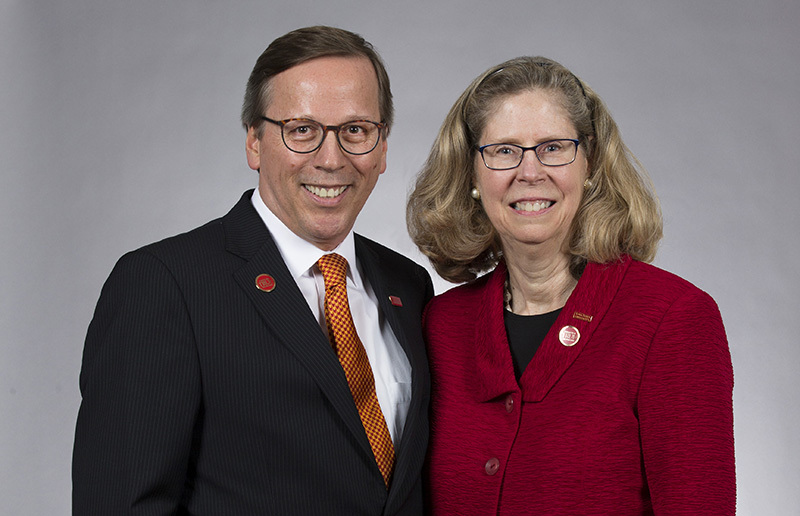
President Wendy Wintersteen with her husband, Robert Waggoner, after Wintersteen was selected as Iowa State's 16th president on Oct. 23. Photo by Christopher Gannon.
Wintersteen begins
Other coverage of new President Wendy Wintersteen in this week's edition of Inside Iowa State:
As Wendy Wintersteen transitions from college dean to Iowa State president, a major adjustment also is afoot for her husband, Robert Waggoner.
"There is no traditional role for the dean’s spouse, but historically there has been for the president’s spouse. For Robert, the last month has been a steep learning curve in understanding those expectations.” Wintersteen said in an interview with Inside this week.
A university president's spouse typically has a role in ceremonial settings and fundraising, and some wives of previous Iowa State presidents formally and informally have been called first lady. As the first female president in Iowa State history, Wintersteen said she put some thought into what her husband's title would be.
"While that may seem a small deal, it also serves to set a precedent for the university and deserves some extra attention," she said.
Wintersteen said she consulted with a friend who is the chancellor at North Carolina State University.
"He said, 'Wendy, all you have to do is this. At formal events, they'll introduce you as President Wintersteen, and she's joined by her husband, Robert Waggoner.' And that's how we’re going to think about Robert," she said. "He will join me in many events at the Knoll and help host them. He will join me in fundraising trips. He'll join me at student events, at athletic events. He'll be a part of what I do for the university, and likely develop his own special areas of focus as time goes on."
Waggoner's title, imprinted on his ISU Card, is "President's Spouse."
"At the same time, he has his own interests that he'll remain deeply engaged in, as well," Wintersteen said.
Wintersteen and Waggoner both hail from Kansas. They began dating when Wintersteen was working for Iowa State Extension and Waggoner was working toward the psychology degree he earned from Drake University in 1981. They've been married since 1984.
Waggoner worked for a small manufacturing business in sales and marketing for 26 years before switching careers a decade ago to write books on lucid dreaming -- the scientifically validated ability to realize you are dreaming while in a dream state. His two books have multiple printings and translations in French, German, Korean, Czech, Finnish and, soon, Chinese. He gives presentations at universities and conferences around the world and is the past president and current treasurer of the International Association for the Study of Dreams, which publishes the scientific-refereed journal, Dreaming.

President Wendy Wintersteen and Robert Waggoner, the president's spouse, were introduced to the crowd at Jack Trice Stadium at the homecoming football game Oct. 28, five days after she was selected to be Iowa State's 16th president. Photo courtesy of athletics communication.
Kurtenbach steps down as CIO

Jim Kurtenbach
Jim Kurtenbach announced he is resigning as vice president and chief information officer, effective today. Kurtenbach, who also is an associate professor of accounting, said he will return to the College of Business where he earned tenured faculty status in 1997.
Kurtenbach has been vice president and CIO since July 2016. He served as interim CIO, beginning in January 2015.
"Jim has been integral in enhancing security across the university’s enterprise technologies; modernizing IT infrastructure; implementing Canvas, a new learning management system; and initiating the switch to Workday to update and streamline our information systems and processes," said President Wendy Wintersteen. "We greatly appreciate his leadership over the past three years with these important projects."

Kristen Constant
Wintersteen named Kristen Constant, Morrill Professor and chair of the materials science and engineering department, to serve as interim vice president and chief information officer, beginning Dec. 1. Wintersteen said Kurtenbach and Constant will begin working together immediately to facilitate a smooth transition. The state Board of Regents will consider formal approval of Constant’s interim appointment at a later date.
Constant has been with Iowa State since 1992, when she joined the College of Engineering. In addition to her role as department chair, she is the Wilkinson Professor of Interdisciplinary Engineering.
"I am pleased that Kristen has agreed to serve as interim vice president and CIO," Wintersteen said. "She has the expertise to keep us on track as we move toward full implementation of Workday. We look forward to how this complex, multiyear endeavor will ultimately transform our administrative functions for the 21st century, improving human resource, finance and student business processes and services campuswide.”
New office will coordinate race and ethnicity programs, training
Senior vice president for student affairs Martino Harmon has created a university office dedicated to race and ethnicity training and programming. It will include coordinating the Thomas L. Hill Iowa State Conference on Race and Ethnicity (ISCORE), held in March, and Iowa State's participation in the annual National Conference on Race and Ethnicity (NCORE), held in early June.
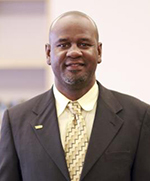
Japannah Kellogg
Japannah Kellogg, who has served as director of the federal TRIO Student Support Services program since 2003, is the first director of the NCORE-ISCORE project office. Kellogg has been involved with the two conferences since his arrival on campus in 2000 as a multicultural liaison officer in the College of Liberal Arts and Sciences.
For the last 13 years, Harmon noted, coordinating the conferences consumed about one-third of Kellogg's time, even though officially that effort was buried in the "other duties as assigned" piece of his job. Discussions about creating a separate office go back several years.
"Not many schools have what we have now," Martino noted, "but we wanted to do more, to make this part of the university structure and not a side gig. The demand from those who want to participate in the conferences, the need for more training, the desire to create more partnerships between student affairs and the colleges, all drove this."
While Kellogg's history with, and passion for, NCORE-ISCORE made him an obvious candidate for the job, Harmon also praised the efforts of hundreds of campus volunteers over nearly two decades.
"We've reached this stage in our evolution because of the contributions of many, many volunteers," Harmon said, "and we'll still count on their help moving forward."
Great students
Kellogg first became aware of Iowa State at an NCORE he attended on behalf of a Minnesota university.
"I was really impressed with the pockets of Iowa State students I met at that NCORE. The project drew me to Iowa State," Kellogg said. When a job opportunity came on campus, he took it.
Harmon and Kellogg agreed that conversations about race and ethnicity are among the most difficult to have. Formalizing a project office should create more opportunities for those to occur, they said.
Kellogg is enthused about the possibilities.
"We have some history now, we know what's worked and why. But there are things we haven't tried, some value-added ideas," he said. "We'll create the structure so the project has its own legs if we take [Japannah Kellogg] out of the equation, if we take a few really loyal volunteers out of the equation."
Harmon outlined these plans for the NCORE-ISCORE project office:
- Two staff members, Kellogg and an assistant, plus student employees
- An office in 3219 Memorial Union
- An unwavering commitment to student development and leadership
- A collaborative partnership with the office of the vice president for diversity and inclusion, to strengthen programs and avoid duplication
- Enhancements to the NCORE and ISCORE offerings, such as professional development for more faculty and staff
- New programming -- for example, a smaller version of ISCORE that includes the Ames community
- Training for a group of students who would provide peer-to-peer education on race, ethnicity, diversity and inclusion
The inaugural ISCORE was held in March 2000, to share and build on Iowa Staters' experiences at the 12th annual NCORE the previous summer. ISCORE attendance has grown each year. And last June, Iowa State sent its largest delegation of students, faculty and staff (80) to the national conference.
Rob Lipsey, a program adviser in Student Support Services, began serving as interim director of the office on Nov. 20. Kellogg's transition to his new position will conclude by the end of December.
Proposal for top floor of ATRB goes to regents
The unfinished fifth floor of the new Advanced Teaching and Research Building would become home to the interdisciplinary Nanovaccine Institute in a proposal going to the state Board of Regents on Dec. 6. The board will meet via telephone, with the meeting based at the board office in Urbandale. The meeting agenda and an audio livestream are on the board website.
Iowa State will seek permission to begin planning for a headquarters and state-of-the-art research space for the institute, a consortium of 70-plus scientists at 21 universities, health care companies and national laboratories. Anson Marston Distinguished Professor in chemical and biological engineering Balaji Narasimhan serves as director. The project budget is estimated at up to $6.5 million, to be covered by university funds and private gifts.
The first four floors of the new facilty, located at the northwest corner of Pammel Drive and Stange Road, are scheduled to open next semester.
Professional development requests
Iowa State will submit its request for 43 faculty professional development assignments in the fiscal year that begins July 1, 2018. This compares with 42 in the current year and a recent five-year average of 38. The proposed FY19 group includes 29 males and 14 females, and their plans vary in length from a semester (28), full academic year (12), something in between (two) to a full calendar year (one).
All Iowa State faculty employed at least half-time, regardless of length of service, may apply for a PDA, typically used to pursue intensive research or scholarship, or prepare publications. Fifty-two Iowa State faculty, out of an eligible 1,865, applied for an assignment. Priority may go to tenured faculty over non tenure-eligible, and to faculty who haven't received a PDA in the past five years. The average length of service for the proposed faculty recipients is 11.8 years.
Dietetics graduate degree
The full board will be asked to approve a Master of Professional Practice in Dietetics (MPPD), a non-thesis, online graduate degree in the food science and human nutrition department. By 2024, a master's degree will be required to take the national credentialing exam. Demand for the MPPD program is high among current graduate certificate students. The board's academic and student affairs committee reviewed the proposal in October.
Capital projects
These Iowa State projects will be presented to both the property and facilities committee and the full board next week:
- ISU Dining proposes to renovate and reconfigure two-thirds of the Hub interior to reduce congestion. Alternatives for the Hub were part of a broader food service study last spring. The plan would move the coffee venue to the north end of the building (phase 1), separating it from the grill area. The southeast corner of the building, now used primarily for vending, would be converted to storage. The existing seating areas will be renovated. ISU Dining will pay for the estimated $2.4 million project. The proposed timeline calls for bidding the project in the spring, with the coffee venue ready by the start of fall semester and the grill area several months later.
- The university proposes to gut and reconfigure 14 restrooms across all five levels of the northwest section (1961 addition) of Parks Library. The renovations would provide accessibility compliance and add a family restroom to each floor. The proposed $2.3 million cost would be covered by university funds.
- The athletics department proposes to expand and reconstruct the parking lots immediately north and south of Hilton Coliseum (C1 and C2) and the roads on the east and west sides of the building. The project includes additional sidewalks, new lighting, improved accessibility and a dedicated parking area for the visiting team bus. A new event-only north driveway to Lincoln Way is being considered. The estimated $3.8 million cost would be covered by athletics department funds.
Approved by the property and facilities committee in October, these ISU requests also will go to the full board for approval next week: A revised budget for the cancer therapy addition to the small animal hospital at the College of Veterinary Medicine, officially creating the Center for Multiphase Flow Research and Education in the College of Engineering, a revised budget for the window replacement project at Wallace-Wilson residence halls, and a two-summer $4.8 million project to replace all the windows and blinds in Friley residence hall.
The Knoll is being readied for the next first family
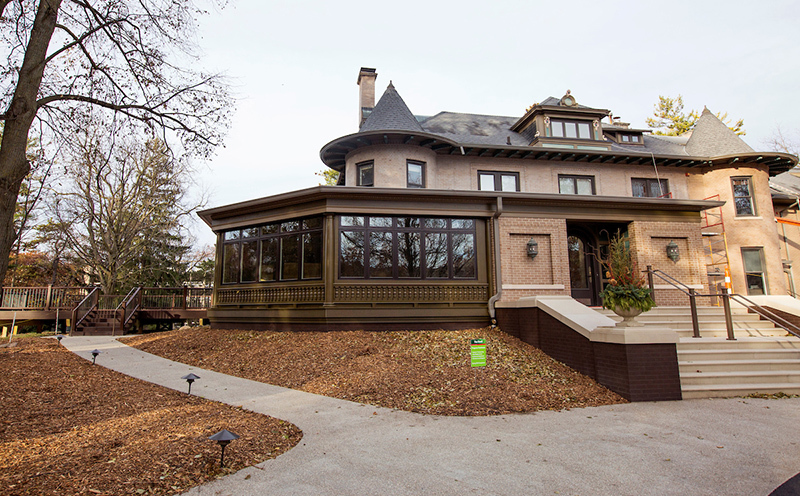
A new south deck (left), four-season room (center) and front steps were modifications to the Knoll initiated by former President Steven and first lady Janet Leath. Below is a 2015 image of the Knoll, before the renovation began. Photos by Christopher Gannon.
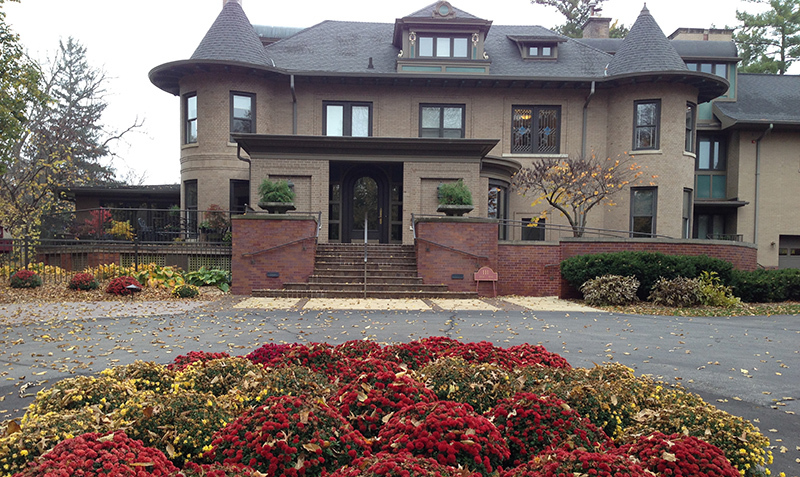
The university's annual WinterFest celebration Dec. 1 will not include an open house at the Knoll, due to ongoing repairs, routine maintenance and restoration. The homemade cocoa recipe of former first lady Ellen Parks (1965-86) has become part of the holiday tradition at the Knoll in the last decade, and President Wendy Wintersteen assures attendees that it will be back in 2018.
Wintersteen begins
Other coverage of new President Wendy Wintersteen in this week's edition of Inside Iowa State:
Wintersteen and her husband, Robert Waggoner, expect to move into the Knoll, the campus home for Iowa State's first family, sometime in December. Actually, it's a required condition of her appointment. They plan to sell their Ames home, which overlooks Veenker golf course.
Ongoing work
In the past year, a four-season room was added to the south side of the Knoll, along with new stairs and a wheelchair-accessible ramp to the front door, projects initiated in 2016 by former President Steven and first lady Janet Leath. Several periodic maintenance projects also are underway or in planning. Tuck pointing of the exterior walls will wrap up in December, and the roof is due for replacement in the spring. The home's boiler will be replaced next summer.
"Anyone who lives in an older home knows of the challenges in terms of maintenance and upkeep," Wintersteen said. "While Robert and I are required to live in The Knoll, we understand it’s more than just the president's house, it's a very special, historic space for the university. We're excited to host events and gatherings there for members of the Iowa State community and friends and supporters of the university."
The Wintersteen-Waggoner move in will be coordinated around maintenance work and updates to the private residence on the second and third floors of the Knoll, which include painting, carpeting, some electrical and wood work, and updates to the private kitchen. The cost of the work is estimated at $150,000.
On Oct.19, the state Board of Regents gave Iowa State permission to begin work on an evolving list of improvements estimated to cost up to $750,000. Four days later, Wintersteen was named Iowa State's 16th president and dramatically pared back the project.
"The suggested list of improvements was extensive. Given the budget situation at Iowa State, it simply wasn't appropriate," she said.
The Knoll was completed in 1901, with additions made in 1922, 1967 and 2001.
The Knoll: Summary of recent improvements
Periodic maintenance needs
- Tuck pointing (fall 2017)
- Replace roof (spring 2018)
- Replace boiler (summer 2018)
Funding: University funds, estimated $535,000
Exterior renovations to the public spaces (essentially complete, 2013-16 requests approved by State Board of Regents)
- Replace southeast deck with a four-season room
- Replace front entry and wheelchair-accessible ramp
- Add south deck off of garden/dining room
- Remove small west deck
- Replace and add sidewalks and lighting (improved accessibility, safety)
- Replace plantings, update landscaping (multiyear plan wrapping up in spring 2018)
Funding: Private gifts to ISU Foundation, $835,000
Interior maintenance and updates to the private residence on the second and third floors, as part of the presidential transition. President Wintersteen reduced the scope of work to:
- Painting
- Replace carpet
- Updates to 2001 private kitchen: renovate island, replace appliances, update fireplace
- Replace hallway light fixtures
- Replace bathroom fixtures
Funding: Non-general fund sources, estimated $150,000
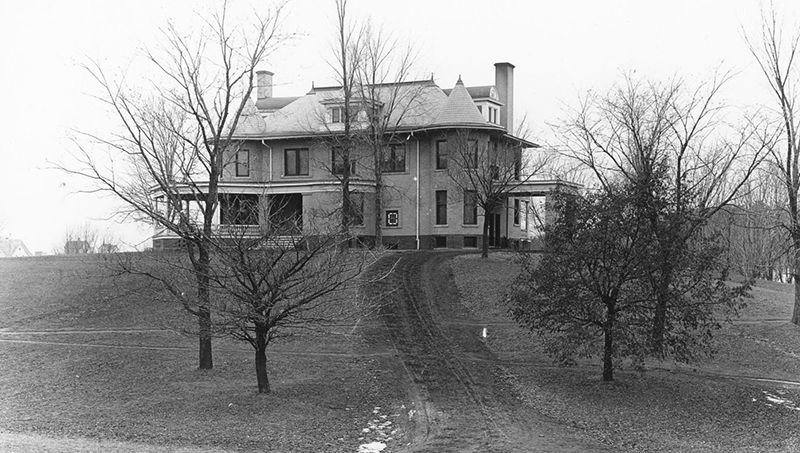
The Knoll shortly after it was completed in 1901. Archive photo.
Wintersteen makes state funding case to governor
President Wendy Wintersteen presented her first state funding request Nov. 28 to Gov. Kim Reynolds, Lt. Gov. Adam Gregg, Iowa Department of Management director David Roederer (who develops the governor's budget recommendations) and members of their staffs. She was joined by her peers from Iowa's regent institutions.
Wintersteen pledged to leverage every tax dollar and tuition dollar "as efficiently and effectively as possible. It's our unwavering commitment to our students, their families and the taxpayers of Iowa."
More info
Wintersteen's presentation slides
For the fiscal year that begins July 1, 2018, Iowa State's requests have not changed from those the state Board of Regents approved in September: $5 million in incremental operating funds, to be designated for resident undergraduate financial aid; and a building request of $100 million, spread over five years, to replace the state Veterinary Diagnostic Laboratory on the College of Veterinary Medicine campus.
Wintersteen noted that the VDL plays a critical role in securing Iowa’s $32.5 billion animal agricultural industry and received full accreditation earlier this month. However, in its report, the site visit team expressed significant concerns about the age of the facility, especially given the rapid growth of the lab. That combination could limit the lab's ability to respond to a large-scale animal disease outbreak, according to the report.
Wintersteen said the state's investment "will pay dividends for decades to come by helping secure one of Iowa's most important industries."
Her other messages focused on Iowa State's efficiency and its land-grant record of service in educating Iowans, conducting fundamental and applied research that improves lives, and extending innovation to the state and the world.
"As a land-grant institution, we derive our value by helping Iowans and the state be successful. This has been our mission for 160 years, and it is as relevant and critical today as it ever has been," she said.
In her first audience with the governor as ISU president, Wintersteen closed by saying, "I very much look forward to working closely with this administration to advance public higher education, research and extension in Iowa."
Welcome winter at WinterFest, Dec. 1
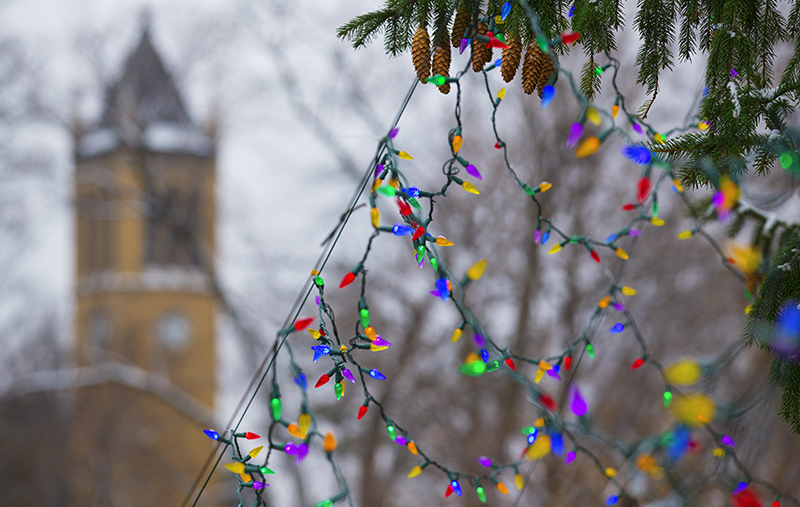
Photo by Christopher Gannon.
This week's warm temperatures may not feel like it, but winter is coming. Instead of dreading it, why not embrace it? Slip on some mittens and a hat (or maybe shorts and flip flops will suffice) and enjoy the blizzard of activities planned for WinterFest 2017 on Dec. 1. Events are free (unless indicated) and open to all.
Following is a synopsis of this year's festivities; some activities extend beyond Dec. 1 and are noted. No open house at the Knoll is planned this year due to the presidential transition and ongoing construction at the home. The event is slated to return next year.
- Holiday kick-off sale (8 a.m.-7 p.m., ISU Book Store, Memorial Union), faculty and staff who show their university ID will receive a coupon for 40 percent off one ISU apparel item (from 4 to 7 p.m.), other discounts throughout the store
- Art Mart holiday sale (Nov. 30, 10 a.m.-6 p.m.; Dec. 1, 10 a.m.-6 p.m.; Dec. 2, 10 a.m.-1 p.m., MU Campanile Room), pottery, blown glass, jewelry, photography, accessories, $5-$25 (proceeds benefit the artists, Workspace and Gaffers' Guild)
- Andy Albright Jingle Jog 5K (3-5:15 p.m. registration, MU Multicultural Center; race begins at 6 p.m., front of Beardshear Hall), $20
- Seasonal beverage sampling (4-7 p.m., MU Market & Café), flavors include candy cane white mocha and egg nog latte
- Cards for kids (4-8 p.m., MU Cardinal Room), cards will be distributed to inpatient units and residential homes of ChildServe
- Campanile tours and carillon music (4-7 p.m., campanile), led by university carillonneur Tin-Shi Tam
- Holiday crafts (4-10 p.m., MU Workspace)
- Chair massages (4-10 p.m., MU Gold Room)
- Bowling and billiards (4-10 p.m., MU CyBowl and Billiards)
- Karaoke and button making (5-8 p.m., MU Gallery)
- Bingo (5-9 p.m., MU Pioneer Room)
- Photo booth (5-9 p.m., MU Main Lounge)
- Tree lighting ceremony (5:30 p.m., steps of Beardshear Hall), President Wintersteen and leaders of student organizations will speak
- Photos and photo snow globes with the Snow Princess and Ice Queen (6-8 p.m., MU Multicultural Center)
- Chili, corn muffins, cookie decorating and hot chocolate (6 p.m., MU Trophy Tavern)
- Carriage rides (6-9:30 p.m., pick up north side of MU)
- Yoga classes (6-9 p.m., State Gym)
- Scavenger hunt (6-9 p.m., State Gym, Beyer Hall, Lied Center), find clues on recreation services' Instagram, @isurecservices
- "Just Dance" video game (6-9 p.m., MU Maintenance Shop)
- Cyclone Cinema, "It" (7 and 10 p.m., 101 Carver)
- Concert, Judah & The Lion, with Wilder (8 p.m., MU Great Hall), $25 ($15 for students)
- Ice skating (10 p.m.-2 a.m., Ames/ISU Ice Arena), free for the first 1,000 participants, $3 per person after that
Support student organizations
The Horticulture Club is holding a poinsettia sale Nov. 30 (10 a.m.-4 p.m., ground floor, Beardshear Hall), Dec. 1 (10 a.m.-4 p.m., entrance to ISU Book Store, MU) and Dec. 2 (10 a.m.-4 p.m., main hallway, Reiman Gardens). Poinsettias are available in two sizes -- a 6.5-inch pot for $12 and a 10-inch pot for $32.
The Forestry Club is selling trees and wreaths in the parking lot of Reiman Gardens on the following days:
- Dec. 1, 8 (3-6 p.m.)
- Dec. 2, 9 (9 a.m.-5 p.m.)
- Dec. 3, 10 (noon-5 p.m.)
Trees include Fraser and balsam firs and Scotch and white pines. Prices range from $30 to $60. Balsam fir wreaths -- 24 or 30 inches, decorated or undecorated -- are $20 to $30.
Block and Bridle Club is raising funds through its annual holiday sausage and cheese sale. To place an order, print an order form and mail or drop off at 120 Kildee Hall by Dec. 6. Email Larissa Becker, Taylor Conley or Shoki Hirano with questions or to place an order.
The College of Design Art Club (CODAC) is sponsoring an art sale Dec. 6, 7 and 8 (10 a.m.-4 p.m., foyer outside dean's office, College of Design) featuring art pieces by Design undergraduate and graduate students. Media include ceramics, prints, photos, wood and textiles. Prices range from $5 to $150.
Large cast brings classic 'Carol' to life
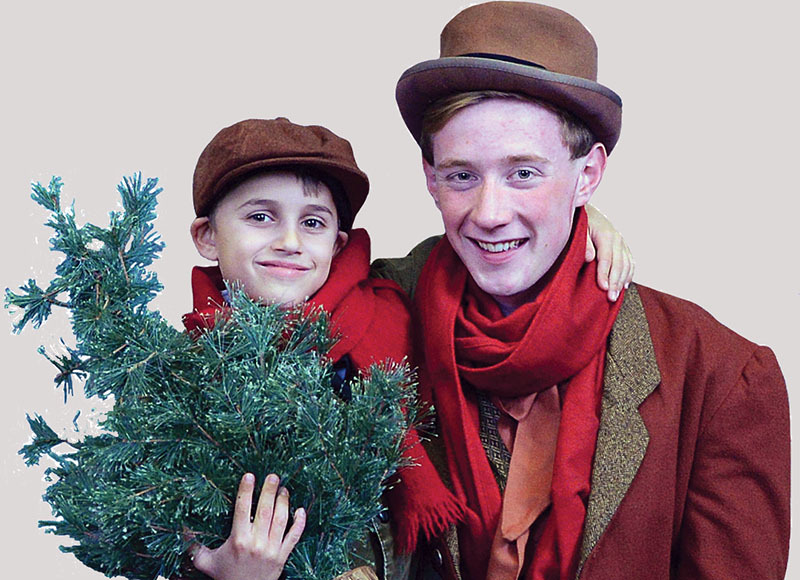
Tiny Tim (Philip Stoytchev), left, and Bob Cratchit (Keaton Lane) help Scrooge change course in ISU Theatre's production of "A Christmas Carol." Photo by James Tener and Nancy Thompson.
The Charles Dickens classic, "A Christmas Carol," returns to the Fisher Theater stage for the first time since 2014. In addition to six public performances that begin Dec. 1, the cast will perform three weekday matinees exclusively for high school students from around the state.
Jane Cox, professor and director of the ISU Theatre production, wrote the adapted version that features more than 50 roles filled by Iowa State students and children from the Ames community. The story stays true to Dickens' novel set in 19th-century England, with well-known characters Ebenezer Scrooge (senior Tyler Hupp), Bob Cratchit (senior Keaton Lane) and Tiny Tim (9-year-old Philip Stoytchev).
After three ghostly visits, Scrooge transforms from a mean-spirited miser to a man embracing the spirit of Christmas. Cox's adapted version adds narrators to the two-act play.
"They add the flavor of Dickens' language," Cox said. "They use his words and are interwoven throughout the play."
Performances are at 7:30 p.m. Dec. 1-2 and Dec. 8-9; 1 p.m. on Dec. 3; and 2 p.m. on Dec. 10. Tickets are $18 ($16 for seniors and $11 for students) and available through Ticketmaster, the Stephens box office or at the door prior to performances. Cox said the production usually draws large audiences. Advance ticket purchases are recommended.
